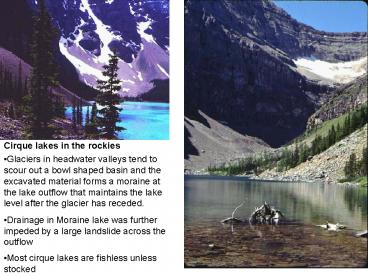Cirque lakes in the rockies - PowerPoint PPT Presentation
1 / 9
Title:
Cirque lakes in the rockies
Description:
Many occupy ancient basins called grabens formed by large geological faults ... Lake in a symmetrical graben. Lake in a tilted graben ... – PowerPoint PPT presentation
Number of Views:57
Avg rating:3.0/5.0
Title: Cirque lakes in the rockies
1
Cirque lakes in the rockies
- Glaciers in headwater valleys tend to scour out a
bowl shaped basin and the excavated material
forms a moraine at the lake outflow that
maintains the lake level after the glacier has
receded. - Drainage in Moraine lake was further impeded by a
large landslide across the outflow - Most cirque lakes are fishless unless stocked
2
(No Transcript)
3
Pothole or kettle lake formed in glacial
--usually small lt 30 ha, but can be quite
deep--10-40 m. Watersheds are very small.
- Large blocks of ice left behind in moraines and
till mounds as glaciers melt and grow stagnant.
- As they gradually melt, they leave behind a
depression in the till that fills by seepage - Many of the small pothole lakes in Alberta are
kettle lakes.
4
Another type of basin associated with ice melting.
Polygonal ponds near the Lena River, Russia
Polygon ponds form along the Arctic coastal
lowlands. Form in the summer as wedges of ice
melt within the permafrost to form
small polygonal basins (around 50 m across) that
fill up with surface water. See Fig. 6.2 in your
text
5
Most of the large and old lakes in the world are
Tectonic lakes Many occupy ancient basins
called grabensformed by large geological faults
Rocks before faulting
Lake in a symmetrical graben
Lake in a tilted graben
6
Lake Baikalone of the most famous tectonic lakes
in the world, has existed for over 20 million
years
7
(No Transcript)
8
Crater Lake, Oregon -589 m deep and possibly the
clearest lake in the world, Transparency up to
90 m. Thermocline very deep for its size No
rooted plants. Mud doesnt accumulate on the
bottom till gt 90 m depth
Why is this lake so different from most lakes?
Some of the most spectacular tectonic lakes are
formed in volcanic craters.
9
- Physical features of lakes that determine habitat
characteristics - inflow from the watershed/Catchment
- Water residence time
- Morphometry, Mean depth and volume
- Thermal stratification and physical mixing
- wind./currents/wave action
- Sediment deposition
- Light extinction































